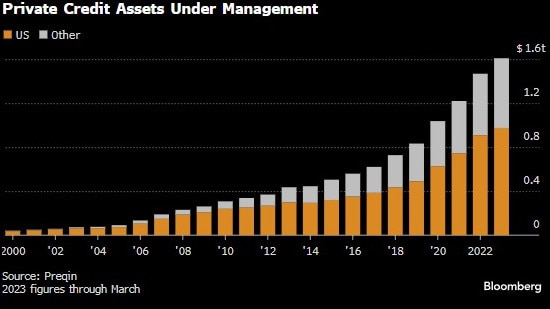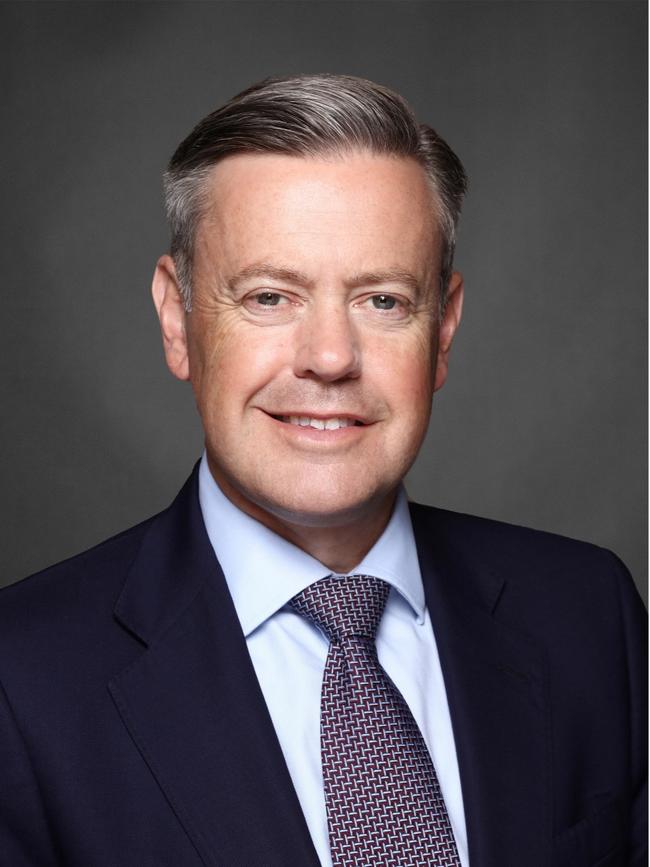T. Rowe Price fundie warns on private credit risks, says high yield bonds a better bet
Private credit, the huge direct lending market replacing bank loans and other types of risky debt, is growing riskier, says a T. Rowe Price fund manager.

Private credit – the ever so popular $US1.7 trillion ($2.6 trillion) direct lending industry that is replacing bank loans and types of risky debt around the world – is also growing riskier, untested at such a large scale, and illiquid.
That makes high-yield bonds a relatively better bet, according to Mike Della Vedova, a Sydney-born, London-based senior portfolio manager at T. Rowe Price, a global fund managing $1.4 trillion for investors.
“At present, we prefer public securities because if the thesis doesn’t quite work out, if there are issues even at a lower level, there is liquidity in the market,” Mr Della Vedova, who oversees high-income strategies, told The Australian in Sydney during a roadshow around the region. “There is a public market where you can exit that investment. (Doing) that is far more difficult on the private side.”
Private debt, where funds lend to companies directly without the involvement of a commercial bank or an investment bank syndicating loans, has seemingly unstoppable momentum.
This lightly regulated corner of the financial markets only had under $100m assets under management as recently as 2000, according to Preqin analysts. But stricter bank regulations have created an opportunity for private credit funds to fill the gap and provide companies with higher-priced financing.
The sophisticated Limited Partners (funds), pension funds, sovereign wealth funds, and insurance companies that first invested in this lightly regulated shadow banking market have extracted high returns with lower levels of risk.
This has not gone unnoticed, and private debt is now one of the hottest asset classes. It is also increasingly being marketed to retail investors around the world, with investment powerhouse Blackrock forecasting private credit will skyrocket to $US3.5 trillion by 2028.
That growth would intensify competition for risky debt and outmuscle the 40-year-old modern high-yield bond market, revolutionised by Michael Milken at the Drexel Burnham Lambert in the 1980s. These bonds are arranged by banks and are assessed by credit rating agencies like S&P Global, Moody’s and Fitch.
“We are looking at a market of around $US2 trillion globally,” Mr Della Vedova said, referring to the “junk bond market”, so-called in light of the riskier nature of these bonds compared to higher-rated, investment-grade debt securities.
As opposed to private credit, the global high-yield opportunity set has shrunk in the past two years. Mr Della Vedova expects growth will return in coming years, driven by an expansion outside the US, but at a slower pace than private markets.

With record numbers of private credit funds seeking to put capital to work, many riskier companies that used to fund through the bond market are now turning to funds that lend directly, he said.
Mr Della Vedova said the migration had actually been beneficial to the public bond market. This was because riskier companies whose smaller size, financial situation or lower credit rating would have made it hard to be funded or refinanced in the public market were now departing to the private credit side.
“Some of those corporates were not able to meet the terms or the conditions that the public debt market wanted to lend them money. And so they had to find an alternative source, and that alternative source has for a large part of last year been the private market,” he said.
Indeed, close to 60 per cent of high-yield bonds are now rated in the top ‘‘BB’’ bracket of the six-level scale for risky bonds that goes all the way through B to C and default. That is up from close to 40 per cent before the 2008 financial crisis, indicating the market’s improved credit quality.
“Most private, direct investments we’ve seen come in have largely been in those situations where the public debt market was not willing to fund that risk, and therefore the private market was used as an alternative source of capital, not a competing source of capital,” he said.
When it comes to returns, global high income bonds, as measured by the Bank of America Global High Yield index hedged to Australian dollars, returned 12.3 per cent in 2023, net of fees. T Rowe’s high income fund outperformed that by 1.3 per cent, also net of a 0.62 per cent management fee.
Private credit, on the other hand, is a much more opaque and illiquid market. Sparse reporting in 2022 and 2023 has shown widely different valuation among funds for the same loans.
Still, according to Bloomberg, the asset class – where fees tend to be higher than for public high-yield bond funds – returned 1.8 per cent in the December quarter.

That is equivalent to an annualised rate of 7.2 per cent, which has outpaced the performance of private equity funds in the past two quarters by a long mark. That has been because returns by the latter have been squeezed by rising interest payments and delayed asset sales to avoid realising investment losses.
However, private credit funds often say the asset class offers the best “risk-adjusted” returns in the long term, arguing the asset delivers the highest returns for a given level of risk.
But Mr Della Vedova warns the jury is not out yet, as the enormous current private credit market has not faced a real economic downturn or “credit cycle”, and this could lead to unexpected losses if economic conditions worsen.
“(The risk-adjusted question) is something we will have to look back at in a few years,” he said.
“The private debt market is relatively new in the scale that’s been utilised.”
“It hasn’t gone through an economic credit or a rate cycle yet. Until a market really goes through those, it’s very hard to see how it performs on a risk/value-adjusted basis, because it hasn’t seen all the risks come to fruition.”
That was because a large proportion of the outstanding loans in the private debt market were originated or refinanced in the wake of the Covid pandemic or after, where governments pumped virtually free money into the system that meant leverage was extremely cheap.
Another key difference between the two types of risky debt is that high-yield bonds generally pay fixed coupons, while private credit carries floating rate payments that are based on the “risk-free” cost of debt plus a “spread” according to the level of risk.
Mr Della Vedova said current yields of just below 8 per cent in global high yield bonds were more than fair compensation for the level of risk and liquidity of the market. “You are being compensated for the downside risk for any defaults that we see in the next 12 months, which we expect to only be moderate this year.” He said those yields were likely to come down if bond yield curves fell globally in the near term, as he expected.
“They aren’t going to stay at these elevated levels forever,” he said. “It’s an opportunity to fix now, and may not exist again at these types of attractive levels in 12 months time.”
Default rates in the global high yield market last year ranged between 1.5 per cent in Europe to 2.4 per cent among US bonds, and 6.21 per cent in emerging market bonds.
But this is where management skill comes into play.
According to Mr Della Vedova’s presentation to advisers across Australia last week, T. Rowe has avoided high-yield investments in companies like global cosmetics group Revlon, which filed for bankruptcy in 2022, or recently restructured real estate company Adler Group.







To join the conversation, please log in. Don't have an account? Register
Join the conversation, you are commenting as Logout